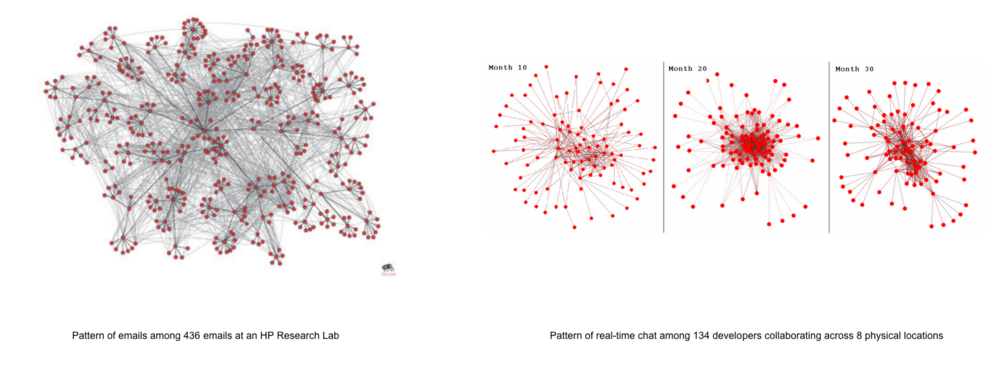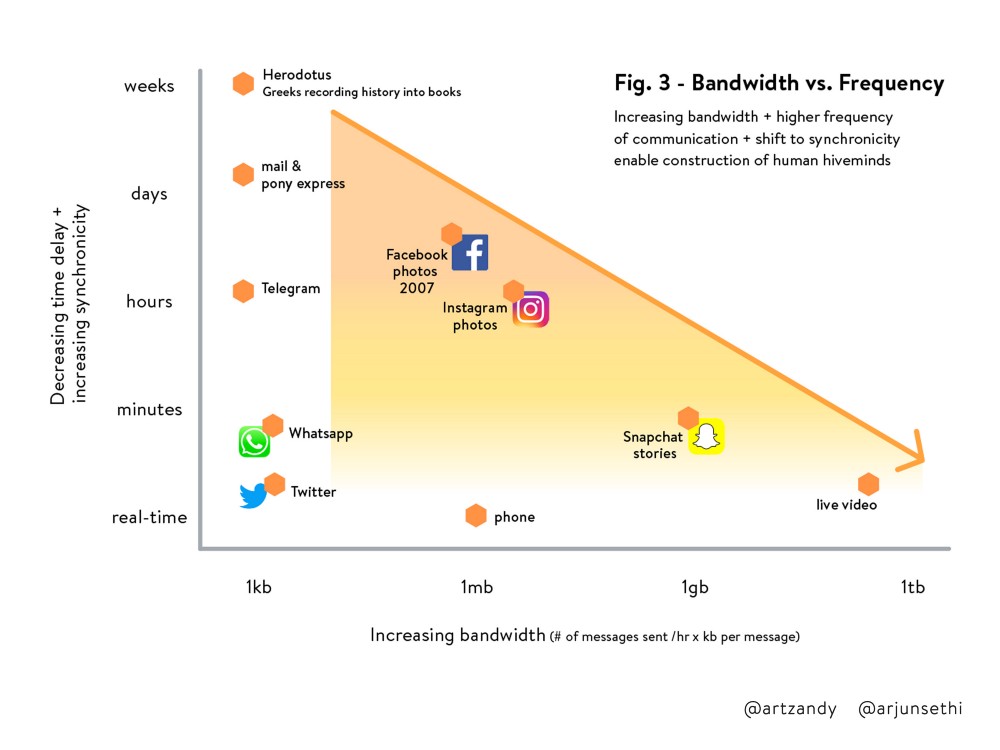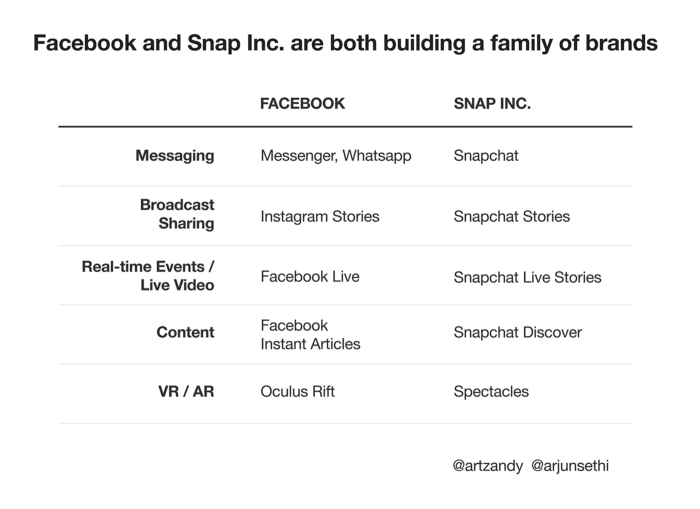Facebook, Twitter and Instagram all started life as revolutionary networks that brought existing real-world relationships online. Today, they are aging utilities, powering an outdated version of the social internet.
As social networks like Twitter, Facebook, and Instagram grow larger, they skew disproportionately toward supernodes—celebrity, meme and business accounts. An estimated 8% of all accounts are fake spam bots. The average Instagram user posts 2.69 times a day, while the average user with over a million followers posts 8.58 times. 80 million photos are posted a day, but the average engagement rate per post is 1.1%. On Instagram, 50% of posts are generated by less than 3% of accounts. Facebook is a bit more stable because it has a cap on the number of friends you can have. Still, original sharing like posting photos to your Facebook feed or updating your status is decreasing 21% year over year.
Today it’s no longer enough to “connect the world.”
If you want to survive, don’t just build a network. You have to build a hive, and eventually a hivemind.
The Existential Crisis of the Network
Even though some social networks have grown to include billions of people, the ramp up in communication hasn’t increased proportionally. Even as you add friends or follow users, you can only talk to so many. Facebook users with over 500 friends only actively communicate with between 10 to 20 people. Similarly, Twitter users who have follower counts of over 1,000 share strong ties with fewer than 50 of their followers.
Myspace’s rapid user growth precipitated an equally rapid decline. It’s a cautionary lesson that growth in the network doesn’t equate to growth in business value. Networks can’t just be neutral. They have to be instrumental.
A network connects different people and gives them many points of contact for communication and transaction. A network is a neutral description of how connections between composite parts form a system. As networks mature, we’re starting to see something completely new emerge.
When it comes to car travel,
Google Maps gives us the distance between point A and point B, but Uber moves us from A to B faster.
When it comes to socializing,
Facebook gives us a way to connect, but Messenger helps us to communicate.
When it comes to shopping,
eBay allows us to buy anything online, but Amazon Prime gives us what we want when we want it.
The value of being connected isn’t in being networked. It’s having an opinion and taking action toward an outcome.
The Hive
A single honeybee weighs around 1/10th of a gram. Add up all the honeybees in a hive, and you get around five to eight pounds worth of honeybees — but you don’t get a hive. The beehive is an 80-pound mass that includes every individual bee, but is much more.
The hive is a smarter, evolved network that is bigger than the sum of its parts. The hive:
- Increases the frequency of interactions between nodes and creates more touch-points within the hive. It’s how the hive learns and makes informed decisions in response to a changing external environment.
- Decreases friction between nodes and creates a higher level of synchronicity between members of the hive. This produces stronger ties between individual members and allows the hive to act collectively.
Because of the increased frequency of interactions, a hive behaves more intelligently, and because of the decreased friction between nodes, a hive can do more than transfer data. It responds and evolves based on that data. The hive isn’t just more networked. It’s more densely populated with organic, living components.
Though not obvious, the hive is becoming central to the way we think, behave and interact. The best way to understand emergent human hives is to observe how hives operate in nature.
Increasing Frequency of Interactions: Ant Colonies Move as Liquids and Solids
An ant colony is so in sync that a mass of them can stick together to form solids or melt into fluids as a single body. By simply holding onto each other or letting go, the viscosity of a cluster of ants changes. They’re able to do so because of the high frequency of interaction between ants in a colony.

For ants, communication is survival. If you apply pressure to a ball of ants, the ants nearest to the top will begin to act as though they are dead, increasing the fluidity of the writhing mass of ants. The harder the ants are pressed, the more fluid they become to absorb the pressure. The more ants there are linked together, the more pressure they can collectively withstand.
What allows ants to adapt so quickly isn’t the content of a transmitted message, but the way one ant presses against another triggers a chain reaction through the entire cluster. It’s how ant clusters can form rafts to avoid drowning and build bridges out of their bodies to cross gaps.
The fluidity of ants allows them to thrive in almost any environment. They’ve colonized every continent except Antarctica, making up 15–25% of terrestrial animals on Earth.
Consumerization of the Enterprise: Mass Alignment in the Workplace
Tools like Google Apps for Work, Slack and Github are making us more like ant clusters. They increase the frequency of interaction within an organization. People can communicate and switch tasks faster, make smarter decisions based on data and use smarter tools that talk to one another.
Rather than being individuals sitting alone in cubicles, we’re like a cluster of ants crawling and moving around and on top of each other with shared tools that everyone can access.

The image above on the left shows how email communication patterns follow organizational hierarchies at an HP research lab. The image on the right shows the pattern of developers collaborating over chat. With a network model like email, you have to jump from one person to the next to get the information you need. In a hive, real-time communication occurs seamlessly between people.
The high frequency of interaction gets everyone on the same page and working in sync:
- People to people interactions: With the hive, a higher frequency of interactions means that work can be assigned on an ad-hoc basis with a tool for real-time chat like Slack. People can switch jobs more rapidly based on what the hive needs. One study shows that the top 20% of developers were also the ones that chatted the most frequently.
- People to data interactions: What was specialized knowledge accessible via technical interfaces is now common knowledge exposed through conversational interfaces. Think Lookerbot for analytics and internal company data.
- Data to data interactions: The workplace hive gives us insight where we once only got reports. Tools that everyone in the company uses creates massive amounts of data, which helps people use tools more efficiently. This workflow data used to be valuable only as a system of record. Today, it produces actual business intelligence.
The net result is a vastly smarter organization aligned around shared goals. With more interaction between workers and tools, a business can transform from solid to fluid depending on the needs of the hive.
Decreasing Communication Friction: Bee Swarms Operate like Neural Nets
A swarm of bees on the move resembles the movement of neurons in the human brain. That’s how they’re able to colonize new nesting sites within hours of leaving their old one.
This doesn’t happen through a centralized intelligence where the queen bee shouts down orders. Instead, it’s through the low-level communication of scout bees that reduces friction for the entire hive and allows for rapid and collective decision-making.
A hive has around three days to find a new nest site before it dies. Finding the right home means exploring possible sites in a one-mile radius of the queen. The queen can’t go out and look at sites on her own, and doesn’t have the bandwidth to process every possible location that the scouts find and make a good decision quickly.
Instead, scout bees — who represent 3% of the entire hive — are responsible for choosing the new hive. When it’s time for the hive to move, around 50 scouts are sent out to look for a promising home. When a scout finds one she likes, she does a “waggle dance” to signal the location to the other scouts. Scouts check out a variety of sites and dance around the one they think will help the hive survive.
As soon as 30 or so scouts gather around a new nest site, the rest of the hive is already lifting off into the air.
The decision-making process of bees reduces friction for how a massive collection of individual parts can evaluate a variety of inputs quickly and intelligently. Ultimately, 30 bees decide the fate for 10,000.
Mobile Messaging: The Formation of WeChat’s Hive
While networks like Instagram and Twitter are beginning to wear thin, messaging apps like WeChat are frenetic hives of activity that build economic empowerment. Like honeybee scouts, messaging apps decrease the friction of centralized nodes in the 1:1 communication between individual nodes and allow for emergent behaviors.

WeChat began five years ago as a messaging service. Today, you can use it to pre-order dumplings from a street-vendor, call a taxi, read the news, and even buy a house.
With WeChat, we see the evolution of a consumer product through the three stages of want, need and utility to the hive. At each stage, WeChat focuses on reducing friction by providing infrastructure for users. On WeChat, all it takes is a critical mass of people adopting new behavior to turn it into a utility that benefits the whole hive.
- Want — 2011: When WeChat launched, it let you send messages, voice clips, photos and that’s about it. Over the next year, as China moved from 2G to 3G, WeChat gave users the ability to make voice and video calls. It automatically compressed videos people uploaded to save cellular data. People wanted to use WeChat because it allowed you to easily — and cheaply — talk to other people.
- Need — 2012: WeChat users in China were often reluctant to download standalone apps because of high data costs. The launch of “official accounts,” or chatbots, emerged within these constraints. People could read the news or check bank statements via text message to an official account. Their needs were met entirely within WeChat’s platform.
- Utility — 2013: The addition of mobile payments and WeChat Wallet provided a new layer of utility for users and drove the wide scale adoption of commercial behavior onto the platform. One group of Chinese students built a fruit delivery business on WeChat because other fruit stands on campus were expensive, poor quality and inconvenient. In an interview, one student points out that “WeChat is a bit more agile [than Taobao]. A small entity can still have its own brand.”
As WeChat grows, new utilities emerge on the platform. Each increases the time users spend on WeChat’s platform thus reducing friction between users. The latest progression of this is the launch of Applets, which will allow developers to build full HTML5 apps on top of WeChat.
What drove WeChat’s growth wasn’t the launch of any one feature. It was the individual fruit vendors, taxi cabs, and mom-and-pop shops that WeChat made life easier for. In the long run, this might be the winning strategy.
In 2015, 12,000 new companies were born on platforms like WeChat every day. The hive isn’t created from access to new functionality. It’s how new functionality creates new economic opportunity.
The Transformation of the Network to the Hive
The increase in the frequency of interaction and decreased communication friction of the hive can be traced to a move toward synchronicity between people over history. Once, a story passed down verbally from father to son turned into myth after a thousand years. The invention of writing and the first spread of literacy allowed the transmission of the first written history.
As technology has advanced, the delay between the transfer of information has decreased. Paved roads allowed couriers to deliver messages, while cables wired along those roads enabled telegraphs and then radio broadcasts. Eventually, you got email, instant messaging, SMS, camera phones, all the way up to live video.

As information networks become distributed from giant data centers to cellular towers and the cloud, the amount of bandwidth available to the individual continues to rise. We’re no longer limited to a broadcast radio model, where one signal is received by many nodes. Today, we send and receive higher quantities of data at higher frequencies, through texts, photos and videos. We sync with each other instantaneously, and all the time.
This is what allows networks to converge into hives, from the individual to the organization.
Instrumentalizing the Social Network
The function of the social network is to connect people and to grow the size of the network. What originally came about through increasing connections is now focused on delivering a better, more immediate experience.
Facebook in 2012:
Our mission is to make the world more open and connected.
Facebook in 2016:
Our top priority is to build useful and engaging products that enable people to connect and share through mobile devices and personal computers.
In 2012, Snapchat described itself on its website as:
Snapchat is the fastest way to share a moment on iPhone — up to 10x faster than MMS!”
Today, the renamed Snap Inc.’s website reads:
We believe that reinventing the camera represents our greatest opportunity to improve the way people live and communicate.
Facebook and Snap Inc. are both converging around how we communicate and share experience, and they’re doing it by building a family of brands.

From the beginning, Snapchat has built itself around the camera and user experience. As the company moved from 1:1 communications to a broader platform for sharing experiences, this has not changed.
Facebook’s efforts to mimic Snapchat’s ephemeral messages as well as its initiatives on products like Instagram Stories and its move into virtual reality through the acquisition of Oculus Rift all demonstrate a move away from the network, and toward a moments-driven hive.
The original experience of Facebook was more connected, but also a lonely experience. You put one version of yourself online and lived another one in real life. The original Facebook showed a version of you that you wanted to see.
Rather than alienating people, Facebook and Snap Inc. today are moving toward a vision of the future around creating real, shared experiences that actually bring people together.
Google, Uber, Tesla and Autonomous Vehicles
The map is possibly the most literal rendering of the network. A map connects physical locations together, and shows you how to navigate from one point to another. The autonomous car is built on top of the map, but it’s instrumentalized around actually taking you between points.
- Autonomous vehicles can be imagined because they’re built on top of the information networks of Google’s Maps and Streetview, projects that Google undertook to organize the world’s information.
- At Tesla, they’re building autonomous electric vehicles on top of their network of vehicle sales, service centers and Supercharger stations. Self-driving Teslas have already collected 100 million miles of autonomous driving data and 780 million miles of human driving data from the sensors it builds into each vehicle.
- Meanwhile, Uber is moving towards autonomous cars through the ride-sharing marketplace it has built. Through the Uber app, the company collects 100 million miles of driving data each day. In contrast, the average American only drives 15,000 miles a year.
Why are all these vastly different companies converging on the autonomous car? That’s because for these companies, it’s about platform and hive, not just about roads without drivers.
Google’s 10-K, 2016:
From the start, the company has always strived to do more, and to do important and meaningful things with the resources they have.
Uber’s blog, 2016:
The old Uber was black and white, somewhat distant and cold. This belied what Uber actually is — a transportation network, woven into the fabric of cities and how they move. To bring out this human side — the atoms — we’ve added color and patterns.
For Google, the search giant, it’s about putting information to work. It is leveraging its massive data sets, of roads, driver behavior, and physical objects, and continuously feeding data back to the system. Uber, meanwhile, has evolved from a white glove black car service into a transportation hive. Through logistics and cleaner, cheaper interfaces, Uber directs human actions more efficiently through algorithms. The autonomous car was the next logical step.
By allowing cars to get from A to B more predictably, autonomous cars will reduce the number of cars on the road, and the number of deaths in car accidents, and even the amount of money for insurance. The hive is what gives us a shot at collectively solving these seemingly impossible problems.
The Future is the Hivemind
A network’s value is traditionally tied to the idea of more—this is what’s known as a “network effect.” The more people and things there are networked, the more possible connections there are between nodes, and the more valuable the network grows.
And yet, the world we’re moving to will be defined by the idea of more with less. Global warming and drought mean fewer resources to work with. At the same time, population growth is beginning to stall across America and Europe, and with it the “free lunch” economic growth that comes with a rising population.
A hive is more than the sum of its parts. Through the hive, a network of drivers and riders also work as a turnkey resource that other services can be built on top of. For companies that operate as hives, sheer quantity matters less than it did for older generations of companies. By increasing interaction and decreasing friction between nodes, they accelerate growth through virtually unlimited, real-time access to data and people.
Hives colonize instinctively as they grow, which is why we’re seeing so many companies converge around the similar trends. But the sequence that they grow in matters. The next big companies will have to do more than just pick the right trends. They’ll have to nail the right timing by moving in sync with their composite parts.
They won’t just be hives. They’ll be hiveminds.
If you enjoyed reading this post, you’ll enjoy the preamble to the hivemind and where the idea was incepted from w/ Andy Artz.



